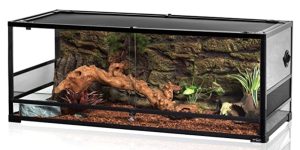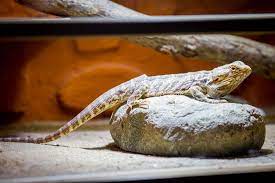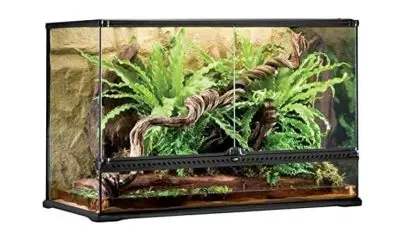What Size Tank Do I Need For A Bearded Dragon? The answer to this question holds the key to providing optimal care for these fascinating reptiles. Bearded dragons come with specific habitat requirements, and selecting the right tank size is paramount for their overall well-being. In this comprehensive guide, we’ll delve into the crucial factors that determine the appropriate tank size for a bearded dragon, ensuring a habitat that promotes comfort and thriving. Whether you’re a novice reptile enthusiast or a seasoned dragon keeper, understanding the significance of tank size is essential for fostering a happy and healthy life for your scaly companion.
What size tank is suitable for a baby bearded dragon?

When it comes to selecting an enclosure for a baby bearded dragon, it’s important to provide a habitat that meets their needs for comfort, safety, and growth. A 20-gallon long tank is generally considered a suitable size for a baby bearded dragon. This size allows for proper temperature gradients and space for the dragon to explore.
However, keep in mind that as your bearded dragon grows, you’ll need to upgrade the size of the enclosure. Adult bearded dragons typically require at least a 40-gallon breeder tank or larger, depending on the size of the individual. Providing a spacious and enriching environment is crucial for their well-being.
In addition to the size of the tank, make sure to include appropriate lighting, heating, substrate, and furnishings such as hides, branches, and basking spots to create a comfortable and stimulating habitat for your baby bearded dragon.
Regular cleaning and maintenance of the enclosure are also important for their health. Always refer to reliable care guides or consult with a veterinarian for specific recommendations based on the needs of your individual dragon.
How large should the tank be for an adult bearded dragon?
The size of the tank or enclosure for an adult bearded dragon depends on various factors, including the age, size, and activity level of the dragon. However, a common recommendation is to provide a minimum enclosure size of 75 gallons for a single adult bearded dragon.
Some reptile enthusiasts even suggest larger enclosures, such as 120 gallons or more, to offer ample space for the dragon to move around and engage in natural behaviors.
It’s important to consider both horizontal and vertical space, as bearded dragons are known for their love of climbing. Providing branches, rocks, and other structures can enhance the living environment and stimulate physical activity.
Remember that these are general guidelines, and individual dragons may have different needs. Regular observation of your bearded dragon’s behavior and adjusting the enclosure accordingly is essential to ensure their well-being.
Additionally, maintaining proper temperatures, UVB lighting, and a suitable substrate are crucial aspects of creating a healthy habitat for your bearded dragon.
Is a 20-gallon tank sufficient for a juvenile bearded dragon?
A 20-gallon tank is typically considered suitable for a juvenile bearded dragon, especially when they are smaller and younger. However, as the bearded dragon grows, you will need to upgrade the enclosure size to accommodate its increasing size and activity level.
It’s generally recommended to move up to a larger tank as the dragon grows to ensure it has enough space to move around, explore, and engage in natural behaviors.
As a rough guide, you might want to consider upgrading to a larger enclosure, such as a 40-gallon or 75-gallon tank, as your bearded dragon reaches sub-adult and adult sizes. Providing an appropriately sized enclosure is important for the overall well-being and development of your bearded dragon.
Additionally, make sure the enclosure is well-equipped with proper lighting, heating, and a substrate suitable for juvenile bearded dragons. Regularly monitor your dragon’s behavior and adjust the enclosure setup as needed.
What are the space requirements for a bearded dragon habitat?
The space requirements for a bearded dragon habitat depend on the age, size, and activity level of the dragon. Here are some general guidelines:
- Juvenile Bearded Dragon (Up to 6 months):
-
- A 20-gallon tank is suitable for a juvenile bearded dragon. This provides enough space for them to move around and explore.
- Ensure there are hiding spots and basking areas, along with proper heating and UVB lighting.
- Sub-Adult Bearded Dragon (6 months to 18 months):
-
- As the bearded dragon grows, consider upgrading to a 40-gallon or larger tank to accommodate its increased size and activity level.
- Provide a variety of climbing structures and basking spots. Bearded dragons are known for their love of climbing, so vertical space is beneficial.
- Adult Bearded Dragon (18 months and older):
-
- For adult bearded dragons, a minimum of a 75-gallon tank is recommended. Some keepers prefer even larger enclosures, such as 120 gallons or more, to give the dragon ample space.
- Include a mix of rocks, branches, and other decor to create a stimulating environment. Adequate space allows for natural behaviors like exploring and basking.
Remember that these are general guidelines, and individual dragons may have different preferences and space requirements. It’s crucial to observe your bearded dragon’s behavior and adjust the habitat accordingly.
Proper heating, UVB lighting, and a substrate that is safe and easy to clean are also essential components of a bearded dragon habitat. Regular cleaning and maintenance are important to keep the enclosure hygienic and the dragon healthy.
What factors determine the ideal tank size for a bearded dragon?

Several factors determine the ideal tank size for a bearded dragon, and these factors may change as the dragon grows. Here are key considerations:
- Age and Size:
- Juvenile bearded dragons require smaller enclosures, such as a 20-gallon tank. As they grow, they will need larger spaces. Sub-adult and adult bearded dragons typically require a 40-gallon to 75-gallon tank or even larger.
- Activity Level:
- Bearded dragons are active reptiles, and they benefit from having space to move around, climb, and explore. Providing an enclosure with both horizontal and vertical space is important.
- Behavioral Needs:
- Bearded dragons have natural behaviors, including basking, climbing, and hiding. A well-designed enclosure should include basking spots, hiding places, and climbing structures.
- Temperature and Lighting Zones:
- Bearded dragons require specific temperature gradients and access to UVB lighting. The enclosure should be large enough to provide distinct temperature zones, including a basking area with higher temperatures and a cooler area.
- Enclosure Furnishings:
- Consider the furnishings and accessories in the enclosure, such as rocks, branches, and substrate. These elements contribute to the overall space utilization and environmental enrichment for the dragon.
- Enclosure Shape:
- The shape of the enclosure matters. A longer and wider enclosure is generally better than a tall one, as bearded dragons are more terrestrial and benefit from ample floor space.
- Health and Well-Being:
- An appropriately sized enclosure supports the physical and mental well-being of the bearded dragon. Inadequate space can lead to stress, lack of exercise, and other health issues.
- Future Growth:
- Consider the potential growth of the bearded dragon. Planning for a larger enclosure as the dragon matures helps avoid frequent upgrades and provides a stable environment.
Always remember to monitor your bearded dragon’s behavior and adjust the enclosure as needed. Regularly check for signs of stress, illness, or discomfort. Providing a suitable habitat with proper heating, lighting, and substrate is essential for the overall health and happiness of your bearded dragon.
Is a 40-gallon tank necessary for a bearded dragon?
A 40-gallon tank is often considered a minimum size for a sub-adult bearded dragon, and it provides more space for them to move around and explore than a smaller enclosure.
While some keepers may start with a 20-gallon tank for juvenile dragons, it’s generally recommended to upgrade to a larger enclosure as the dragon grows.
Here are some reasons why a 40-gallon tank or larger is often recommended for sub-adult and adult bearded dragons:
- Adequate Space: Bearded dragons are active reptiles that benefit from having enough space to move around. A larger enclosure allows for more natural behaviors, such as climbing and exploring.
- Temperature Gradients: Larger enclosures make it easier to create distinct temperature gradients, including a warm basking spot and a cooler area. This is essential for maintaining the dragon’s health and well-being.
- Behavioral Enrichment: A larger tank allows for the inclusion of more accessories, such as rocks, branches, and hiding spots, which contribute to the dragon’s environmental enrichment.
- Reduced Stress: Providing ample space helps reduce stress in bearded dragons. Inadequate space can lead to behavioral issues, such as pacing or aggression.
While a 40-gallon tank is a common minimum recommendation, some keepers choose even larger enclosures, such as 75 gallons or more, to give their bearded dragons an even more spacious and enriched environment.
Always observe your individual dragon’s behavior and adjust the enclosure size and setup based on its specific needs. Regular veterinary check-ups can also help ensure that your bearded dragon is healthy and thriving in its habitat.
Conclusion
You will get the answer to the question What Size Tank Do I Need For A Bearded Dragon on this page. For a bearded dragon, the size of the tank is crucial for its well-being. While a 20-gallon tank may suffice for a juvenile, it is generally recommended to upgrade to a larger enclosure, such as a 40-gallon tank, as the dragon grows.
Sub-adult and adult bearded dragons typically require even larger spaces, with 75 gallons being a common minimum recommendation. Providing sufficient space is essential for promoting natural behaviors, creating temperature gradients, and ensuring the overall health and happiness of the bearded dragon. Always observe your dragon’s behavior and adjust the tank size accordingly to meet its specific needs.


